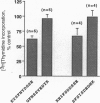Abstract
Cell proliferation is a key primary process during neural development and also plays an important role in the regenerative response of neural tissue to injury. It has been reported that glial cell proliferation is, at least in part, controlled by a neuronal signal, possibly involving cell surface molecules. We report here that the addition of purified rat neural cell adhesion molecule (N-CAM) to primary cultures of rat forebrain astrocytes inhibits their proliferation. This inhibitory effect can be elicited in cultures grown in chemically defined serum-free medium or in medium that had been supplemented with growth factors. Polyclonal antibodies to N-CAM or their Fab' fragments elicited a similar inhibitory effect. The magnitude of the inhibitory effect of N-CAM was dependent on cell density: it was maximal at low cell densities and weakened progressively as cells approached confluency. Synthetic peptides with sequences identical to a putative homophilic binding region of N-CAM mimicked the effect of purified N-CAM, while peptides of the same length and amino acid composition but with a randomized sequence did not. The addition of N-CAM antisense oligonucleotides to primary astrocyte cultures for 48 h resulted in reduced levels of N-CAM expression. After N-CAM levels on astrocytes were diminished by this treatment, the antiproliferative effect of N-CAM added to the medium was significantly reduced. The combined results suggest that N-CAM homophilic binding may be involved in the control of glial cell proliferation.
Full text
PDF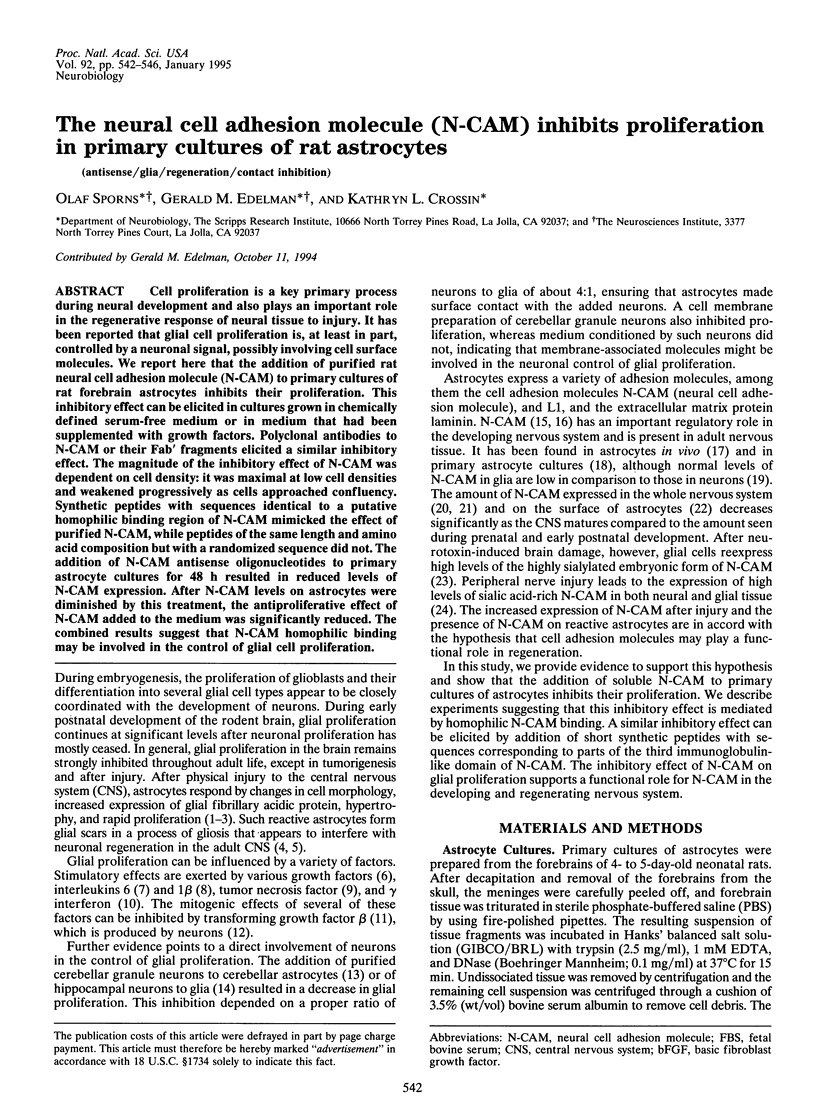
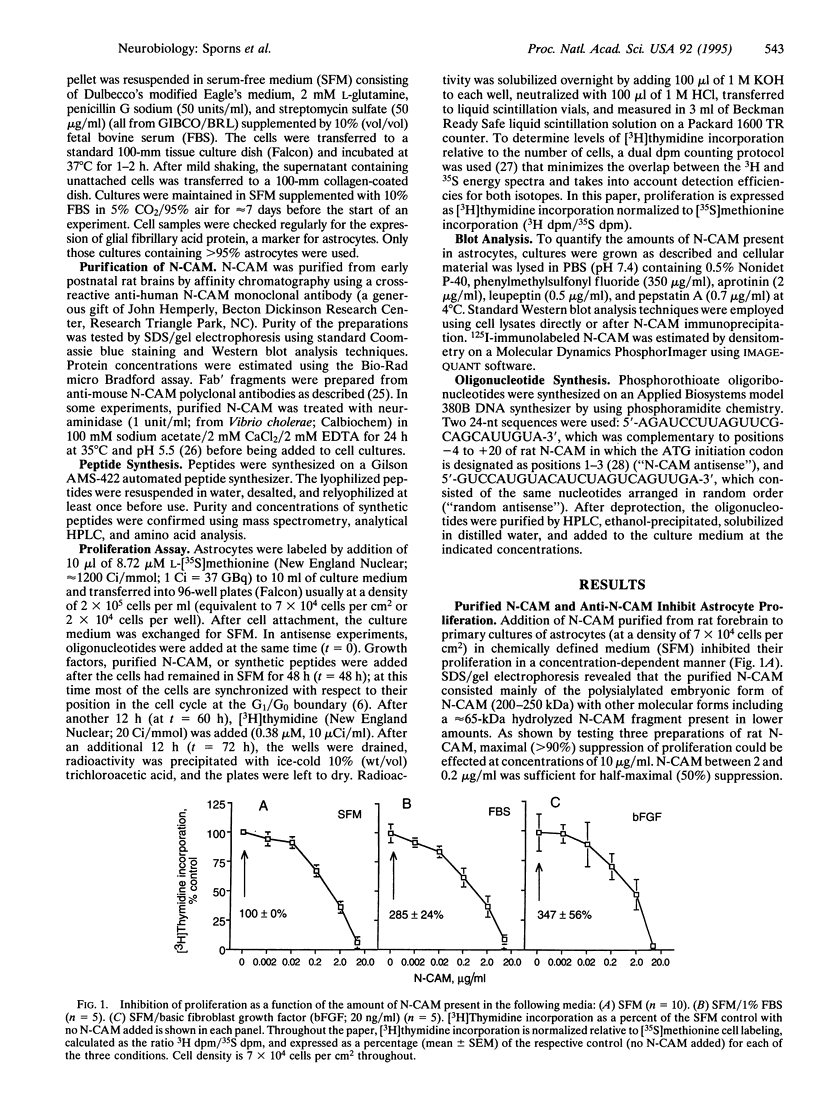
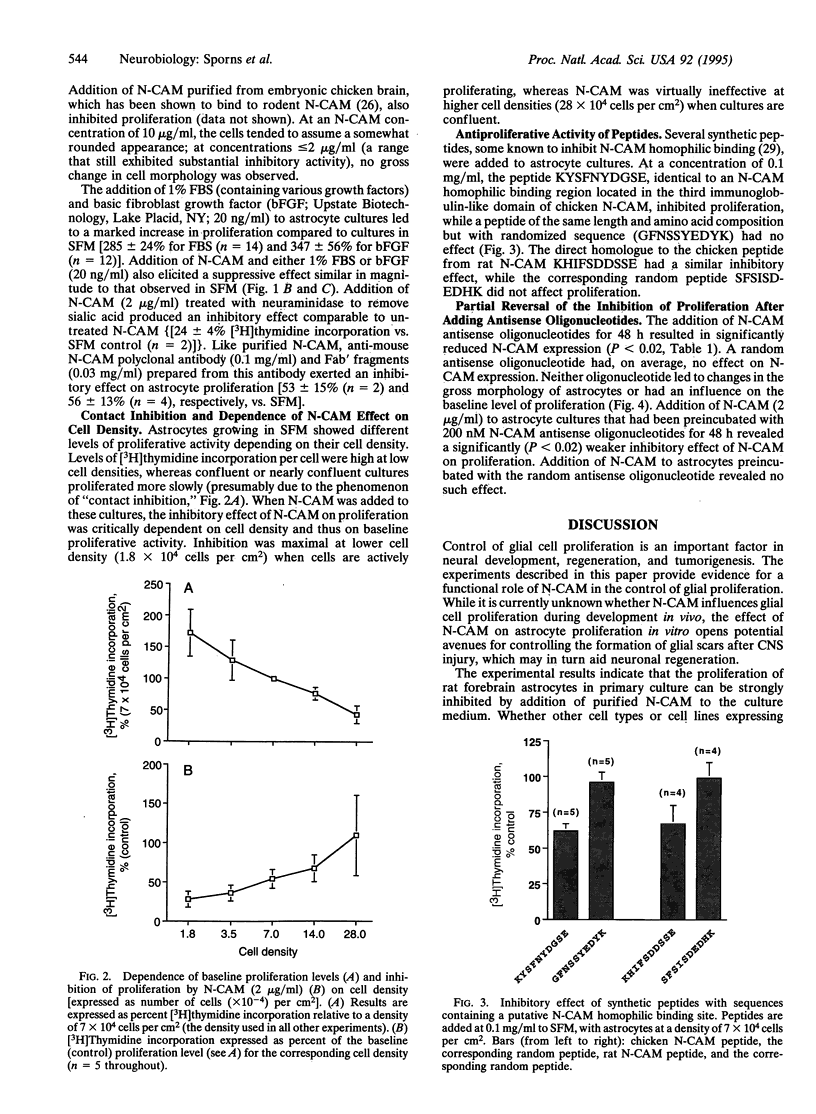
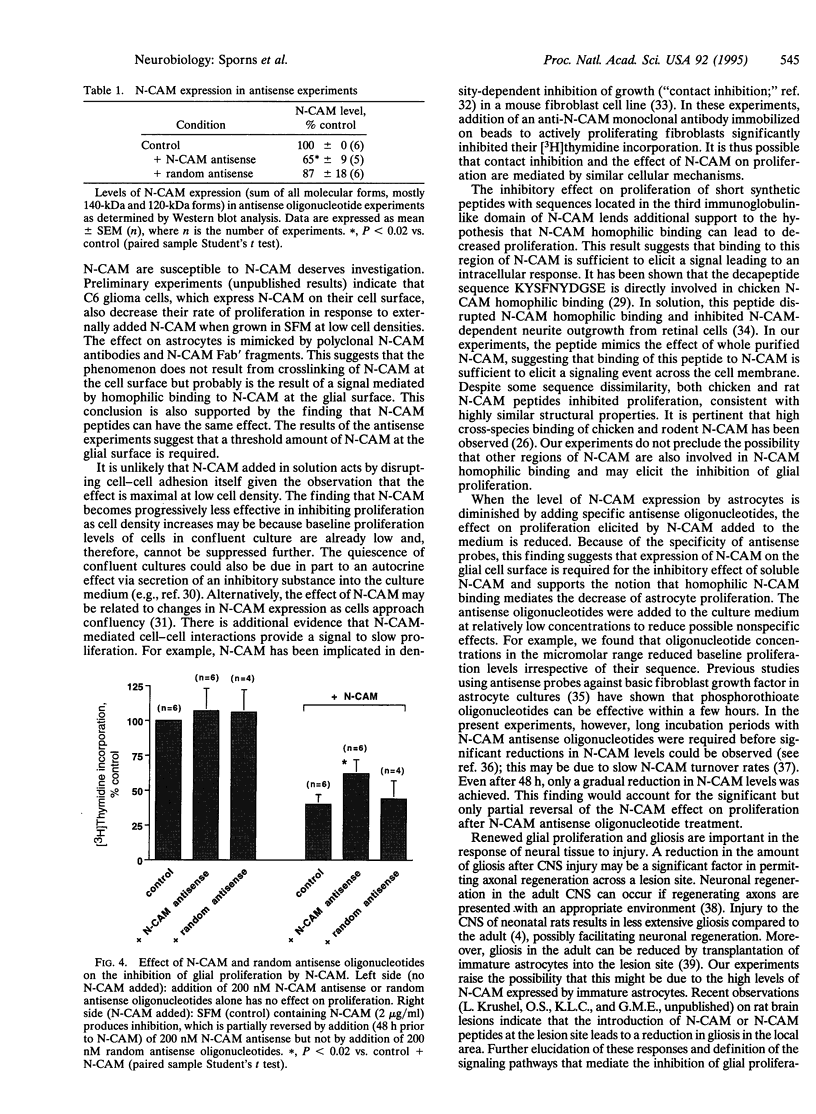
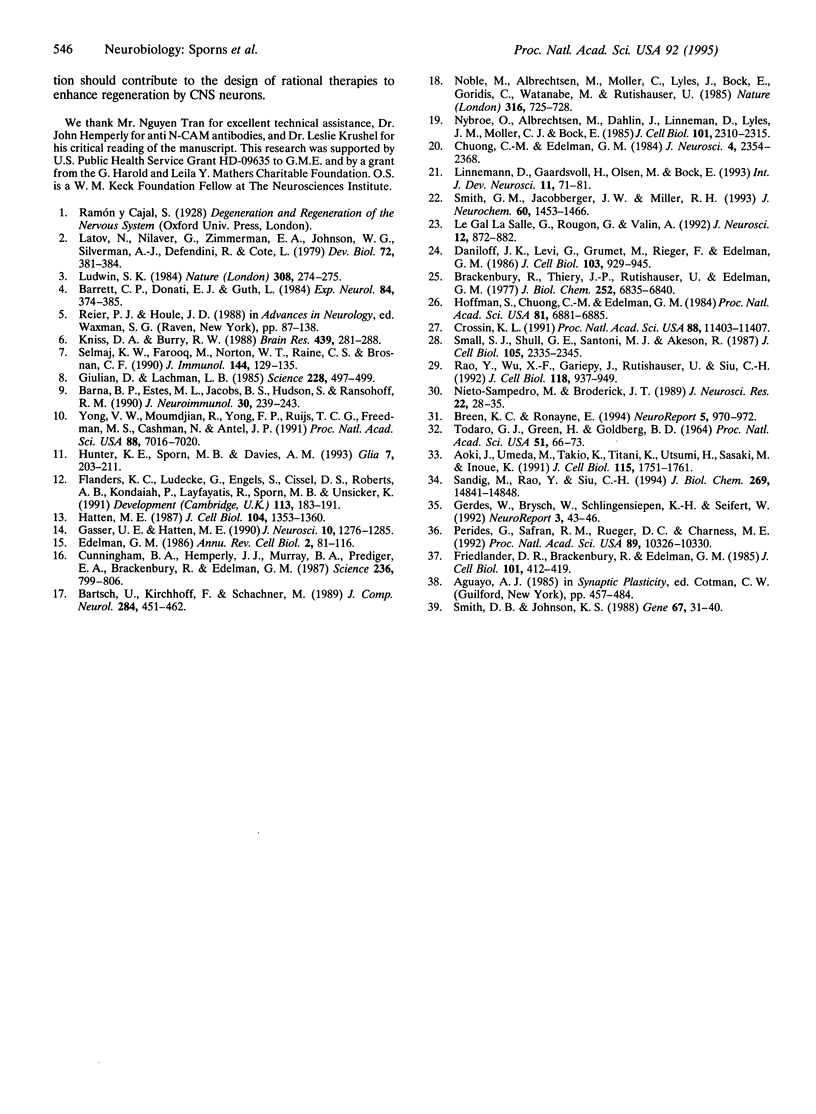
Images in this article
Selected References
These references are in PubMed. This may not be the complete list of references from this article.
- Aoki J., Umeda M., Takio K., Titani K., Utsumi H., Sasaki M., Inoue K. Neural cell adhesion molecule mediates contact-dependent inhibition of growth of near-diploid mouse fibroblast cell line m5S/1M. J Cell Biol. 1991 Dec;115(6):1751–1761. doi: 10.1083/jcb.115.6.1751. [DOI] [PMC free article] [PubMed] [Google Scholar]
- Barna B. P., Estes M. L., Jacobs B. S., Hudson S., Ransohoff R. M. Human astrocytes proliferate in response to tumor necrosis factor alpha. J Neuroimmunol. 1990 Dec;30(2-3):239–243. doi: 10.1016/0165-5728(90)90108-y. [DOI] [PubMed] [Google Scholar]
- Barrett C. P., Donati E. J., Guth L. Differences between adult and neonatal rats in their astroglial response to spinal injury. Exp Neurol. 1984 May;84(2):374–385. doi: 10.1016/0014-4886(84)90234-6. [DOI] [PubMed] [Google Scholar]
- Bartsch U., Kirchhoff F., Schachner M. Immunohistological localization of the adhesion molecules L1, N-CAM, and MAG in the developing and adult optic nerve of mice. J Comp Neurol. 1989 Jun 15;284(3):451–462. doi: 10.1002/cne.902840310. [DOI] [PubMed] [Google Scholar]
- Brackenbury R., Thiery J. P., Rutishauser U., Edelman G. M. Adhesion among neural cells of the chick embryo. I. An immunological assay for molecules involved in cell-cell binding. J Biol Chem. 1977 Oct 10;252(19):6835–6840. [PubMed] [Google Scholar]
- Breen K. C., Ronayne E. The effect of cell confluency state on the expression of neural cell surface glycoconjugates. Neuroreport. 1994 Apr 14;5(8):970–972. doi: 10.1097/00001756-199404000-00029. [DOI] [PubMed] [Google Scholar]
- Chuong C. M., Edelman G. M. Alterations in neural cell adhesion molecules during development of different regions of the nervous system. J Neurosci. 1984 Sep;4(9):2354–2368. doi: 10.1523/JNEUROSCI.04-09-02354.1984. [DOI] [PMC free article] [PubMed] [Google Scholar]
- Crossin K. L. Cytotactin binding: inhibition of stimulated proliferation and intracellular alkalinization in fibroblasts. Proc Natl Acad Sci U S A. 1991 Dec 15;88(24):11403–11407. doi: 10.1073/pnas.88.24.11403. [DOI] [PMC free article] [PubMed] [Google Scholar]
- Cunningham B. A., Hemperly J. J., Murray B. A., Prediger E. A., Brackenbury R., Edelman G. M. Neural cell adhesion molecule: structure, immunoglobulin-like domains, cell surface modulation, and alternative RNA splicing. Science. 1987 May 15;236(4803):799–806. doi: 10.1126/science.3576199. [DOI] [PubMed] [Google Scholar]
- Daniloff J. K., Levi G., Grumet M., Rieger F., Edelman G. M. Altered expression of neuronal cell adhesion molecules induced by nerve injury and repair. J Cell Biol. 1986 Sep;103(3):929–945. doi: 10.1083/jcb.103.3.929. [DOI] [PMC free article] [PubMed] [Google Scholar]
- Edelman G. M. Cell adhesion molecules in the regulation of animal form and tissue pattern. Annu Rev Cell Biol. 1986;2:81–116. doi: 10.1146/annurev.cb.02.110186.000501. [DOI] [PubMed] [Google Scholar]
- Flanders K. C., Lüdecke G., Engels S., Cissel D. S., Roberts A. B., Kondaiah P., Lafyatis R., Sporn M. B., Unsicker K. Localization and actions of transforming growth factor-beta s in the embryonic nervous system. Development. 1991 Sep;113(1):183–191. doi: 10.1242/dev.113.1.183. [DOI] [PubMed] [Google Scholar]
- Friedlander D. R., Brackenbury R., Edelman G. M. Conversion of embryonic form to adult forms of N-CAM in vitro: results from de novo synthesis of adult forms. J Cell Biol. 1985 Aug;101(2):412–419. doi: 10.1083/jcb.101.2.412. [DOI] [PMC free article] [PubMed] [Google Scholar]
- Gasser U. E., Hatten M. E. Neuron-glia interactions of rat hippocampal cells in vitro: glial-guided neuronal migration and neuronal regulation of glial differentiation. J Neurosci. 1990 Apr;10(4):1276–1285. doi: 10.1523/JNEUROSCI.10-04-01276.1990. [DOI] [PMC free article] [PubMed] [Google Scholar]
- Gerdes W., Brysch W., Schlingensiepen K. H., Seifert W. Antisense bFGF oligodeoxynucleotides inhibit DNA synthesis of rat astrocytes. Neuroreport. 1992 Jan;3(1):43–46. doi: 10.1097/00001756-199201000-00011. [DOI] [PubMed] [Google Scholar]
- Giulian D., Lachman L. B. Interleukin-1 stimulation of astroglial proliferation after brain injury. Science. 1985 Apr 26;228(4698):497–499. doi: 10.1126/science.3872478. [DOI] [PubMed] [Google Scholar]
- Hatten M. E. Neuronal inhibition of astroglial cell proliferation is membrane mediated. J Cell Biol. 1987 May;104(5):1353–1360. doi: 10.1083/jcb.104.5.1353. [DOI] [PMC free article] [PubMed] [Google Scholar]
- Hoffman S., Chuong C. M., Edelman G. M. Evolutionary conservation of key structures and binding functions of neural cell adhesion molecules. Proc Natl Acad Sci U S A. 1984 Nov;81(21):6881–6885. doi: 10.1073/pnas.81.21.6881. [DOI] [PMC free article] [PubMed] [Google Scholar]
- Hunter K. E., Sporn M. B., Davies A. M. Transforming growth factor-betas inhibit mitogen-stimulated proliferation of astrocytes. Glia. 1993 Mar;7(3):203–211. doi: 10.1002/glia.440070303. [DOI] [PubMed] [Google Scholar]
- Kniss D. A., Burry R. W. Serum and fibroblast growth factor stimulate quiescent astrocytes to re-enter the cell cycle. Brain Res. 1988 Jan 26;439(1-2):281–288. doi: 10.1016/0006-8993(88)91485-0. [DOI] [PubMed] [Google Scholar]
- Latov N., Nilaver G., Zimmerman E. A., Johnson W. G., Silverman A. J., Defendini R., Cote L. Fibrillary astrocytes proliferate in response to brain injury: a study combining immunoperoxidase technique for glial fibrillary acidic protein and radioautography of tritiated thymidine. Dev Biol. 1979 Oct;72(2):381–384. doi: 10.1016/0012-1606(79)90127-1. [DOI] [PubMed] [Google Scholar]
- Le Gal La Salle G., Rougon G., Valin A. The embryonic form of neural cell surface molecule (E-NCAM) in the rat hippocampus and its reexpression on glial cells following kainic acid-induced status epilepticus. J Neurosci. 1992 Mar;12(3):872–882. doi: 10.1523/JNEUROSCI.12-03-00872.1992. [DOI] [PMC free article] [PubMed] [Google Scholar]
- Linnemann D., Gaardsvoll H., Olsen M., Bock E. Expression of NCAM mRNA and polypeptides in aging rat brain. Int J Dev Neurosci. 1993 Feb;11(1):71–81. doi: 10.1016/0736-5748(93)90036-d. [DOI] [PubMed] [Google Scholar]
- Ludwin S. K. Proliferation of mature oligodendrocytes after trauma to the central nervous system. Nature. 1984 Mar 15;308(5956):274–275. doi: 10.1038/308274a0. [DOI] [PubMed] [Google Scholar]
- Nieto-Sampedro M., Broderick J. T. A soluble brain molecule related to epidermal growth factor receptor is a mitogen inhibitor for astrocytes. J Neurosci Res. 1989 Jan;22(1):28–35. doi: 10.1002/jnr.490220105. [DOI] [PubMed] [Google Scholar]
- Noble M., Albrechtsen M., Møller C., Lyles J., Bock E., Goridis C., Watanabe M., Rutishauser U. Glial cells express N-CAM/D2-CAM-like polypeptides in vitro. Nature. 1985 Aug 22;316(6030):725–728. doi: 10.1038/316725a0. [DOI] [PubMed] [Google Scholar]
- Nybroe O., Albrechtsen M., Dahlin J., Linnemann D., Lyles J. M., Møller C. J., Bock E. Biosynthesis of the neural cell adhesion molecule: characterization of polypeptide C. J Cell Biol. 1985 Dec;101(6):2310–2315. doi: 10.1083/jcb.101.6.2310. [DOI] [PMC free article] [PubMed] [Google Scholar]
- Perides G., Safran R. M., Rueger D. C., Charness M. E. Induction of the neural cell adhesion molecule and neuronal aggregation by osteogenic protein 1. Proc Natl Acad Sci U S A. 1992 Nov 1;89(21):10326–10330. doi: 10.1073/pnas.89.21.10326. [DOI] [PMC free article] [PubMed] [Google Scholar]
- Rao Y., Wu X. F., Gariepy J., Rutishauser U., Siu C. H. Identification of a peptide sequence involved in homophilic binding in the neural cell adhesion molecule NCAM. J Cell Biol. 1992 Aug;118(4):937–949. doi: 10.1083/jcb.118.4.937. [DOI] [PMC free article] [PubMed] [Google Scholar]
- Reier P. J., Houle J. D. The glial scar: its bearing on axonal elongation and transplantation approaches to CNS repair. Adv Neurol. 1988;47:87–138. [PubMed] [Google Scholar]
- Sandig M., Rao Y., Siu C. H. The homophilic binding site of the neural cell adhesion molecule NCAM is directly involved in promoting neurite outgrowth from cultured neural retinal cells. J Biol Chem. 1994 May 20;269(20):14841–14848. [PubMed] [Google Scholar]
- Selmaj K. W., Farooq M., Norton W. T., Raine C. S., Brosnan C. F. Proliferation of astrocytes in vitro in response to cytokines. A primary role for tumor necrosis factor. J Immunol. 1990 Jan 1;144(1):129–135. [PubMed] [Google Scholar]
- Small S. J., Shull G. E., Santoni M. J., Akeson R. Identification of a cDNA clone that contains the complete coding sequence for a 140-kD rat NCAM polypeptide. J Cell Biol. 1987 Nov;105(5):2335–2345. doi: 10.1083/jcb.105.5.2335. [DOI] [PMC free article] [PubMed] [Google Scholar]
- Smith D. B., Johnson K. S. Single-step purification of polypeptides expressed in Escherichia coli as fusions with glutathione S-transferase. Gene. 1988 Jul 15;67(1):31–40. doi: 10.1016/0378-1119(88)90005-4. [DOI] [PubMed] [Google Scholar]
- Smith G. M., Jacobberger J. W., Miller R. H. Modulation of adhesion molecule expression on rat cortical astrocytes during maturation. J Neurochem. 1993 Apr;60(4):1453–1466. doi: 10.1111/j.1471-4159.1993.tb03308.x. [DOI] [PubMed] [Google Scholar]
- TODARO G. J., GREEN H., GOLDBERG B. D. TRANSFORMATION OF PROPERTIES OF AN ESTABLISHED CELL LINE BY SV40 AND POLYOMA VIRUS. Proc Natl Acad Sci U S A. 1964 Jan;51:66–73. doi: 10.1073/pnas.51.1.66. [DOI] [PMC free article] [PubMed] [Google Scholar]
- Yong V. W., Moumdjian R., Yong F. P., Ruijs T. C., Freedman M. S., Cashman N., Antel J. P. Gamma-interferon promotes proliferation of adult human astrocytes in vitro and reactive gliosis in the adult mouse brain in vivo. Proc Natl Acad Sci U S A. 1991 Aug 15;88(16):7016–7020. doi: 10.1073/pnas.88.16.7016. [DOI] [PMC free article] [PubMed] [Google Scholar]



